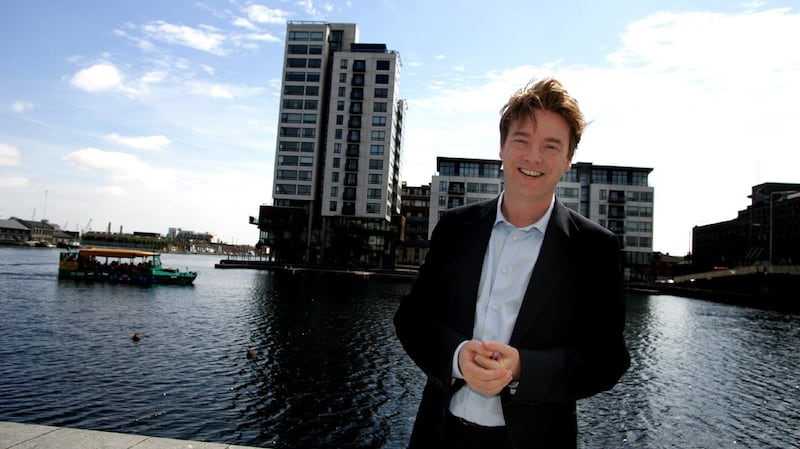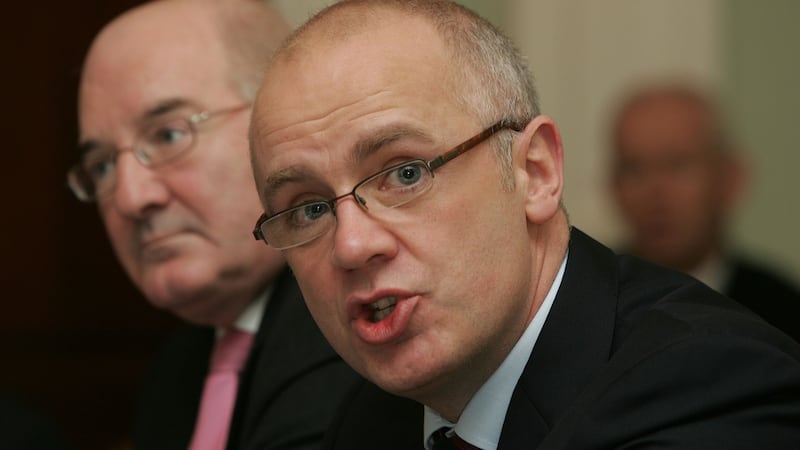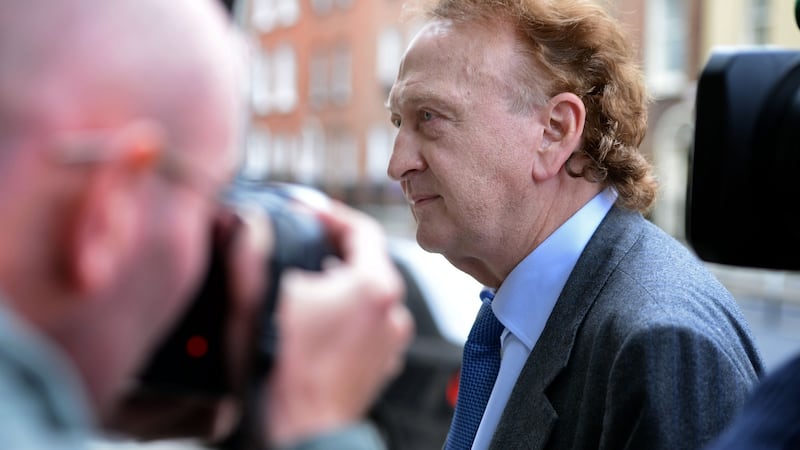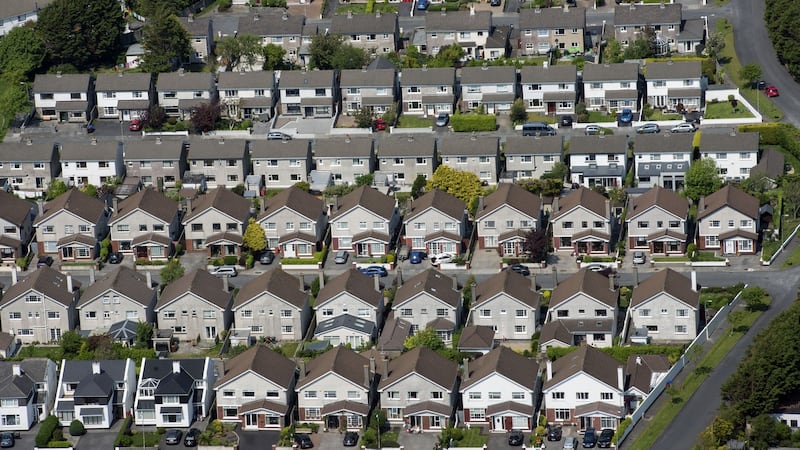Seamus Murphy was something of a maverick in Dublin's small stockbroking community in late 2006 when he suddenly turned negative on Irish banks.
That was after the Davy share trader – who had long held a positive view of the industry, and Anglo Irish Bank in particular – put pen to paper and worked out that a landlord buying a house with a loan faced a 5 per cent interest rate at the time, but only stood to make rental income equivalent to 2 per cent of the property's value.
Even allowing for 10 per cent rental growth a year, Murphy calculated that the landlord would still not be getting enough income to meet the full interest bill on the loan six years after buying the property.
"I realised that if the numbers were still negative beyond the fifth year on cash flows, then there had to be a bubble," Murphy said in an interview with The Irish Times. "If you're buying on a negative carry, you're assuming massive house price appreciation. But then it's a Ponzi scheme, because you're relying on somebody else buying it from you at a higher price."
This Saturday marks the 10th anniversary of the moment the global markets finally caught up, and Ireland's then government was forced into a snap guarantee of the banking system, as investors, scanning the horizon for risk in the wake of the collapse of Wall Street investment bank Lehman Brothers, zeroed in on a market where house prices had quadrupled in a decade, fuelled by debt.
Finance minister Brian Lenihan’s claim at the time that it was the “cheapest bailout in the world” didn’t hold up for long, as taxpayers were forced to back it up with €64 billion of cash injections that would lead ultimately to the State seeking refuge in an international aid programme.
A decade later, Ireland is still counting the cost of the crash.
St Patrick’s Day Massacre
Back in late 2006, Murphy began to make a lot of money for Davy as his clients sold out of Irish banks, earning himself the nickname “the bear” on the firm’s trading floor, even as the shares continued to hit record highs every other day. In early 2007, some overseas hedge funds started to place bets on Irish banking stocks falling through a mechanism called “short selling”.
AIB and Bank of Ireland started to decline from peak market valuations of about €21 billion and €18 billion respectively from late February. Anglo Irish Bank's bull run would continue for a few more months, fuelled, as it would eventually transpire, by the family of businessman Seán Quinn building up a clandestine 28 per cent stake, mainly through financial derivatives.
Murphy's view in early 2007 that Anglo's stock was worth a quarter of its market price would result in a showdown in the lounge of the Westbury Hotel with Anglo's combative chief financial officer Matt Moran that summer – and his embarrassing expulsion, months later, from a bank presentation to analysts and investors.
It also landed Murphy in hot water after the so-called St Patrick's Day Massacre in March 2008, when Anglo's share price plunged up to 22 per cent and the regulator – under pressure from the bank's chief executive David Drumm – launched an investigation into allegations of "false and misleading rumours" being spread by stockbrokers and hedge funds.

“There is this perception that a short seller is negative, but a short sell is actually providing an alternative view in an efficient market,” says Murphy. He would be cleared by the regulator of any involvement in the March 17th sell-off, as he was on holidays at the time.
Harbingers of doom
Murphy wasn't alone in identifying the fallacy propping up western Europe's then fastest-growing economy. University College Dublin economics professor Morgan Kelly, who ordinarily was more concerned with medieval population theory, predicted in an opinion piece in The Irish Times in December 2006 that house prices were set to fall up to 50 per cent. It would earn him the moniker of Dr Doom.
National University of Ireland Galway professor Alan Ahearne and economist David McWilliams would also sound warning bells around that time, prompting then taoiseach Bertie Ahern to say, in July 2007, that those "cribbing and moaning" about spiralling property prices should "commit suicide".
This was all taking place against the backdrop of exuberance internationally. As Alan Greenspan retired from the chair of the US Federal Reserve in early 2006 after two decades as the world's most influential central banker, he left to cheers that he had achieved the "great moderation" of reduced volatility in business cycles.
Closer to home, the UK's then chancellor of the exchequer, Gordon Brown, declared in his 2007 budget speech that "we will never return to boom and bust".
Knowing there’s a bubble is one thing. Knowing when it’s going to burst is something else. Murphy realised that moment had arrived in March 2007 when he brought two clients from New York around to see a number of property agents, developers and others to get a sense of the market.
I remember walking back to the office and thinking, 'This is going to blow.'
“We asked one agent how things were going and he said: ‘Look, residential transactions are down about 70.’ One of the guys I’d brought to the meeting, who was sitting opposite me, said: ‘Sorry, they’re down 7 per cent?’ He replied: ‘No, no, no, they’re down 70 per cent.’
“I still get goosebumps when I think about it. We came out of that meeting at about three o’clock that afternoon and I remember walking back to the office and thinking, ‘This is going to blow.’”
Irish house prices peaked a month later, according to Central Statistics Office (CSO) data. They would fall just over 9 per cent by the time the global financial crisis crescendoed in September 2008 as Wall Street investment bank Lehman Brothers collapsed, dragged down by ill-fated investments in the US subprime market.

The most dramatic month in financial history would see Lehman's nearest rival Merrill Lynch acquired by Bank of America in a rescue deal; US government-backed mortgage firms Fannie Mae and Freddie Mac bailed out by taxpayers; the Washington Mutual bank seized by the US treasury and sold to JP Morgan; and North Carolina-based financial services group Wachovia purchased by Wells Fargo for a bargain-basement price.
In the 24 hours preceding the fateful Irish banking guarantee on September 29th, Dublin-based public-sector lender Depfa Bank ran out of money. Its owner, Munich-based Hypo Real Estate, was forced to secure a €35 billion emergency credit line from Berlin and rival banks. The UK government nationalised stricken mortgage lender Bradford & Bingley, and Benelux financial services giant Fortis was bailed out by the Netherlands, Belgium and Luxembourg.
Irish banking stocks went into freefall as investors searched for risks, with AIB sliding almost 17 per cent, Bank of Ireland dropping 20 per cent, and Irish Life & Permanent plunging about 40 per cent. Anglo Irish Bank collapsed by nearly 50 per cent.
As taoiseach Brian Cowen, minister for finance Brian Lenihan, financial regulator Patrick Neary, government officials, legal advisers and the chairmen and chief executives of the State's two largest banks gathered in Government Buildings on the night of the guarantee, the Dow Jones Industrial Average plunged a record 777points as the US House of Representatives rejected a $700 billion bailout plan for the US financial services industry.
Bad loans rising
Then chief executive of the National Treasury Management Agency (NTMA) Michael Somers, who was in New York at the time attending meetings in relation to the National Pensions Reserve Fund (NPRF), received a text message at 8.20pm local time from his finance director, Brendan McDonagh.
It read: “DOF [Department of Finance] rang. Taoiseach has decided to guarantee all banks and if that does not work, to nationalise.”
McDonagh and his colleague, Oliver Whelan, had been called into Government Buildings that night and were put into a meeting room. They were never consulted until they were informed of the decision at 1am.

“Did I fall out of the bed with shock? No I didn’t,” recalls Somers of reading the text. “At that stage, the problem was seen as a liquidity issue for the banks and not a solvency problem. I don’t think many of us realised at the time that there was going to be this huge issue with bad loans in the banks. That was a shock that grew over time.”
Somers and his team had been wary enough of Irish banks for over a year at that stage. They had decided, in August 2007, to move NTMA deposits with Irish lenders to the Central Bank as they matured.
“The economics I learned was that, as a general rule, you’d expect credit growth to be more or less in line with GNP [gross national product],” said Somers. “But during the boom years, we had credit growing at between 20-30 per cent a year and nominal GNP growing by 7-8 per cent.”
Blowing billions
To put it in context, the €440 billion guarantee was almost 2½ times the size of the Irish economy at the time. It would cost taxpayers €64 billion in direct capital injections into the banks between 2009 and 2011 to keep their creditors whole. The Government expects, ultimately, to recover less than half of that.
All told, the top 11 boom-time lenders in Ireland – including foreign-owned Bank of Scotland (Ireland), Danske Bank and Acc Bank, which would ultimately retreat from the market – reported almost €134 billion of net loan losses over the next decade, the equivalent of more than a quarter of their 2008 loan books, according to calculations by The Irish Times.
The ultimate cost of the bust was far greater, as the NTMA paid above the odds in the years that followed to borrow money in international markets, with investors worried about the solvency of the State. The government would finally be frozen out of capital markets in late 2010, pushing it into an international bailout.
Then there is the human toll. The unemployment rate trebled to more than 15 per cent in the four years to early 2012, even as emigration soared. Almost 13 per cent of owner-occupier borrowers were at least three months behind in mortgage repayments by late 2013.
The Dáil passed some €30 billion of austerity measures between 2008 and 2014, while more than 200,000 boom-time mortgages were in negative equity five years after the crash, according to the Economic and Social Research Institute (ESRI) – a phenomenon that smothers entrepreneurship, hits consumption and roots people to areas that may have limited jobs.

A decade on, and the legacy of the crisis continues to be felt. Home completions this year are set to come in at half the rate of estimated demand for 35,000 houses and apartments, with the effects of an emergency brake being pulled on construction in 2008 still felt.
Average residential rents are now at record levels, some 26 per cent above their Celtic Tiger highs, while almost 10,000 people were homeless in Ireland in July, including a record 3,867 children, according to the latest Department of Housing figures. About 100,000 households are on the social housing waiting list.
Ireland's €201 billion of public borrowings is the third-highest in the developed world – after the US and Japan – on a per-capita basis. And while Central Bank data published earlier this month showed that household debt has fallen to its lowest level since early 2004, it is still the fourth-highest in the European Union.
Home to roost
“There is still a popular view in Ireland that it was a banking crisis which didn’t originate here – that there was a liquidity issue which came from abroad and brought the system down,” an adviser to the Irish authorities at the height of the financial crisis, who declined to be identified, said last week. “But lots of other European banks had liquidity issues at the time and managed to get by.
Many people in Europe were surprised and annoyed by the guarantee move, but the euro zone wasn't ready for a crisis
“Our banking crisis was pretty simple and stemmed from the fact that we were building a load of homes, funded by the banks, where people didn’t want to live. We need to recognise that we did invent it here.”
Dubliner John Hourican, a former top Royal Bank of Scotland (RBS) executive, was key to the UK bank maintaining credit lines with Irish lenders during the crisis as many others pulled funding. He says financial markets quickly "saw through" the guarantee and the Government's ability to back it up.
“Many people in Europe were surprised and annoyed by the guarantee move, but the euro zone wasn’t ready for a crisis, which would unfold like a slow-motion car crash,” said Hourican by phone from Nicosia, where he’s been chief executive of the Bank of Cyprus for almost five years and recently had his contract extended to the end of 2020.
The lack of a way to resolve failing banks in the euro zone during the crisis – and the Irish system's huge reliance on emergency European Central Bank funding for its banks – meant all creditors had to be made whole, except for most junior bondholders, who would have €15 billion of losses inflicted on them.
“With the benefit of being able to analyse everything calmly in hindsight, all bondholders should have been collapsed into equity investors before the State stepped in,” said Hourican.
Rules introduced in the wake of the crisis allow for both junior and senior bondholders to suffer losses in the event of a future crisis, while maximising protections for depositors. For Ireland, these new measures came too late.
Flawed foundations
Property developer Sean Mulryan would live to regret that his Ballymore Group had €2.38 billion of bank borrowings in September 2008 – 90 per cent of which were from Irish banks, even though, at that stage, 85 per cent of the group's assets were overseas, mainly in London.
The Roscommon native, who started off working as a bricklayer before setting out on his own in the early 1980s building one-off houses in Co Kildare, became one of the biggest housebuilders in Ireland within a decade, before making his first foray into the London market in 1991.

For Mulryan, it was clear soon after the turn of the millennium that something was amiss in Ireland.
“London land prices were nowhere near Dublin prices at the height of the market, so we didn’t really engage in the crazy land deals in the early 2000s,” says Mulryan. “Still, we kept the Irish operation ticking over, because we had good teams in the country.”
Still, Mulryan participated in some of the highest-profile property auctions of the bubble years, including the Irish Glass Bottle Site in Dublin, which would be bought in 2006 by a consortium including developer Bernard McNamara, financier Derek Quinlan and the Dublin Docklands Development Authority (DDDA) for €412 million, as well as the Jurys and Burlington hotel sites.
Ballymore subsequently learned that its bids were as much as 35 per cent off the pace at the time.
The scale of Ballymore's Irish borrowings when the banks became a ward of the State – including €1.12 billion from Anglo and almost €300 million at Irish Nationwide Building Society – landed Mulryan in the National Asset Management Agency (Nama) when the bad bank was set up in 2009 to take over risky commercial property loans on lenders' balance sheets.
Mulryan’s business ground to a halt for 12 months as it dealt with the reputational damage of being in Nama and getting clearance from the agency for its business plan.
"I had to give huge commitments, personal commitments, which I'm not allowed to talk about," Mulryan told The Irish Times last week in an interview in a ground-floor art gallery at the group's London City Island development, one of six active sites where it is working in the UK capital, with a gross development value of £4.06 billion(€4.55 billion). "Everything was on the line."
Ballymore exited Nama four days before Christmas 2016, having repaid €3.2 billion in gross debt to the State agency, including working capital and interest given to the group to complete and sell projects.
Basically, the developers were branded as the people who brought down Ireland plc
“I would never be comfortable with debt again,” says Mulryan, adding that Ballymore has no borrowings on 90 per cent of the 9,500 sites on its land bank. Before the crash, its land bank would have had a 60 per cent loan-to-value ratio. “While we will gear our working capital when we’re developing, we’ll always pre-sell or pre-let units before we start piling.”
Mulryan is visibly moved as he describes some of the vitriol he experienced in Ireland since the crash.
“Basically, the developers were branded as the people who brought down Ireland plc. You got it in a lot of places. Many, many incidents shook me,” says Mulryan. “A lot of the housebuilders had to borrow to keep their businesses going and, because there was no land supply, they had to overpay for land. The banks were throwing out money like it was confetti. Everybody had a bit of the blame but some politicians decided that developers were the right target.”
While Mulryan said that “a lot of really good builders” have either walked away from the industry or were forced out by insolvency, he is now more active in Dublin than at any time during the boom: working with Singapore partner Oxley on a one million-plus sq ft mixed development in Dublin’s north docklands, and recently partnering with CIÉ to deliver a major scheme next to Connolly Station on the edge of the International Financial Services Centre.
Ballymore is also currently in a three-horse race to redevelop part of the Guinness Brewery at St James’s Gate in Dublin into a new urban centre, though Mulryan declined to comment on that process.
State lands
While Mulryan says the Government's recently-launched Land Development Agency, aimed initially at freeing up State lands capable of delivering 10,000 homes, should help rein in land prices, he estimates building costs will soar by between 7 and 10 per cent in each of the next two years.
“Because there aren’t enough tradesmen, they’re going to call the tune – and, by the way, builders’ suppliers are just going to go for it, too,” he said. “That’s the biggest risk going forward for development in Ireland.”
The Construction Industry Federation estimates that apprenticeships in Ireland have fallen from a peak of about 27,000 during the boom to about 3,000. It says that about 5,000 need to be signed up a year to meet demand.
Somers’s biggest post-crisis regret is the fact that the National Pension Reserve Fund has not been reinstated. It had over €21 billion invested across more than 2,500 companies globally, as well as in private equity and overseas property at the end of 2007, but was raided during the financial crisis to help rescue the banks.
In its place, the Government established the Ireland Strategic Investment Fund (ISIF), but that offers little geographic diversification, and the promise of a "rainy day fund", into which Minister for Finance Paschal Donohoe has committed putting €3 billion of funds by 2021.
You're creating another bubble, not in the property market his time, but a bubble in rents and social inequality and political inequality
“I thought the pension fund would be reconstituted, as we have a huge pensions time-bomb coming down the tracks,” says Somers. “I think a rainy day fund is a much harder sell than a pensions reserve fund.”
Mortgage rules
Murphy, who left Davy five years ago to set up Carraighill Capital, a low-key independent research provider on European financial systems and bank equities, is now upbeat on Ireland, but says the Central Bank's mortgage rules, introduced in 2015, have had major unintended consequences .
“While I understand what they’re trying to do, only the 5 per cent of the population in Dublin earning over €100,000 could get a mortgage equivalent to the average home price in the city,” says Murphy, referring to the Central Bank rule on most mortgages not breaching 3.5 times income.
“You’re creating another bubble, not in the property market his time, but a bubble in rents and social inequality and political inequality, which is a bubble in itself. When you press down hard on one sector, you’re going to create something on the other side. You just need to get that balance and they’re definitely not getting that balance now.”
Core of the meltdown
The former trader, meanwhile, says he had no idea of the ultimate scale of the impending meltdown when he was making money advising clients to sell Irish banks 12 years ago.
“I still struggle with it. That’s why I haven’t spoken about it for 10 years. People lost a lot of money – and then you look at the real problems that people have had since then,” said Murphy.
“Of course, people will say, blame the bankers. But people have to look deep within themselves, too. Everybody wants to buy tulips or crypto currencies when they are going up. Everybody’s looking for the easy money, right? Property was seen as easy money at the time.”













